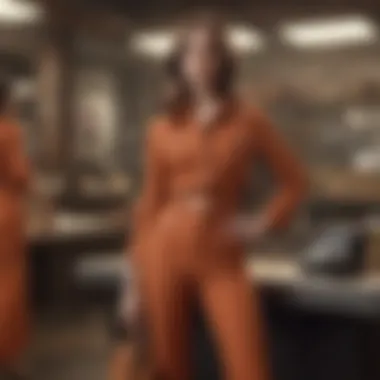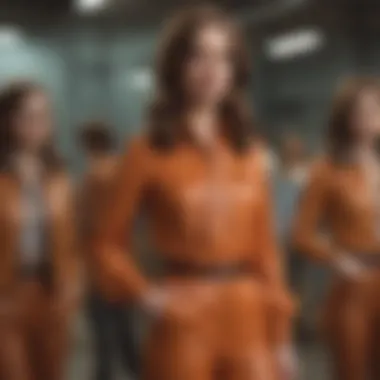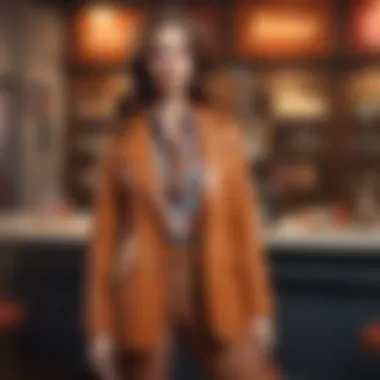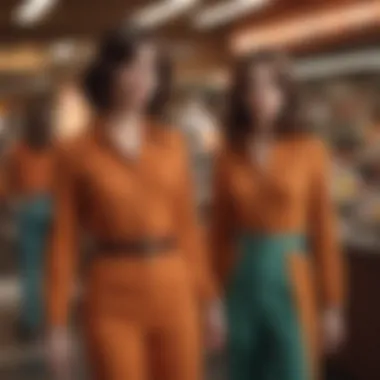Exploring Iconic 70s Style Outfits for Women


Intro
The 1970s was a defining decade for women's fashion. It was a time when society experienced considerable changes that profoundly influenced style choices. Women started embracing a broad range of aesthetics that celebrated freedom, individuality, and self-expression. From bohemian looks that captured the essence of the counterculture movement to the tailored sophistication of disco, the styles of the 70s showcased an extraordinary array of options.
In this article, we will explore the rich tapestry of 70s fashion. We will highlight key trends, dive into the notable elements that characterized this era, and detail how these influences continue to shape contemporary fashion. By examining the societal shifts that guided these trends, we will encourage women of all ages to integrate these timeless elements into their wardrobes today.
We aim to inspire a renewed appreciation for the elegance and complexity inherent in 70s women's fashion. Let's delve into the remarkable aspects of this decade that continue to resonate.
Preface to 70s Fashion
The exploration of 1970s fashion is vital for understanding both the cultural landscape of the time and the evolution of women's style. This era marked a departure from the previous decades, reflecting significant shifts in societal norms and values. Women were gaining more freedom and independence, and this was mirrored in their clothing choices. The myriad of influences in this decade contributed to a diverse fashion scene characterized by experimentation and boldness.
The importance of 70s fashion lies in its ability to connect generations. The styles from this era remain relevant today, influencing modern designers and fashion enthusiasts alike. By revisiting the key trends, one can appreciate the elegance and diversity that defined women's fashion in the 70s. Moreover, understanding this decade provides insight into how clothing can serve as a form of expression.
Cultural Influences on Fashion
The 1970s witnessed a convergence of various cultural movements that profoundly influenced fashion. The countercultural movements, including feminism and civil rights, led to a shift in the perception of women’s roles. This shift encouraged women to adopt styles that emphasized personal identity rather than societal expectations. The rise of music festivals and rock music also played a significant role. Iconic artists, like Janis Joplin and Stevie Nicks, embodied the freedom of expression through their distinctive styles, which became symbols of the era.
Moreover, the impact of globalization introduced diverse patterns and fabrics into the mainstream. Styles from various cultures, including ethnic prints and bohemian designs, gained popularity. This blend of influences allowed for a unique fashion statement that reflected not only personal taste but also the political climate of the times.
Key Characteristics of the Decade
Several defining characteristics marked the fashion of the 1970s. Firstly, silhouettes varied widely, from the figure-hugging to the loose and flowing forms. The maxi dress, for example, became a staple, signifying both comfort and a carefree attitude. Additionally, fabrics such as denim, polyester, and suede contributed to the diverse textures of the decade, appealing to various tastes and styles.
The era is well-known for its color palettes. Bold hues such as orange, yellow, and brown dominated the fashion scene, often accompanied by earthy tones. Patterns like paisley, floral, and geometric prints added visual interest and excitement to garments. Denim became popular for various styles—from flared jeans to jackets—further solidifying the 70s as a decade of bold and adventurous fashion choices.
Signature 70s Style Outfits
The exploration of 70s style outfits for women is essential as it builds a bridge between the past and the present. This era is marked by a rich tapestry of cultural movements and fashion experimentation, leading to distinct styles that resonate even today. Understanding signature outfits from this decade allows women to channel a sense of individuality and expression, embracing the freedom that characterized the 70s. In this section, the focus will be on defining some of the key outfits that define this period, which can inspire modern interpretations.
The Iconic Maxi Dress
The maxi dress, a hallmark of 70s fashion, serves as an essential piece in this discussion. Known for its lengthy, flowing design, it offers both comfort and style.
Fabrics and Patterns
The fabric selection for maxi dresses often includes lightweight materials like cotton, rayon, and chiffon. These fabrics allow for breathability, which is crucial during warmer months. Patterns also played a vital role; floral designs, paisleys, and bold geometric shapes dominated the landscape. The key characteristic of these fabrics is their ability to drape beautifully, enhancing movement. For women today, choosing a maxi dress with vibrant or unique patterns adds depth and personality to any wardrobe. However, one must be cautious to not let overwhelming designs overpower the silhouette.
Styling Tips
When styling a maxi dress, the key is to strike a balance between elegance and casual ease. Layering with a lightweight denim jacket or adding a belt to cinch the waist can alter the silhouette beautifully. An important aspect of styling is shoe choice; sandals or wedges can elevate the look effortlessly. This approach is beneficial as it allows versatility, transitioning easily from day to night. However, one must consider the occasion to ensure that the overall look feels cohesive.
Palazzo Pants
Palazzo pants represent another pivotal style in 70s fashion. These wide-legged trousers exude a sense of relaxed elegance, perfect for various settings.
Finding the Right Fit
Finding the right fit for palazzo pants is critical, as they should be both flattering and comfortable. The characteristic feature includes a loose fit throughout the leg that provides freedom of movement. Opting for high-waisted designs can elongate the figure. A careful consideration is that too much fabric can overwhelm shorter frames. Therefore, knowing one's body type and experimenting with length can enhance the overall appearance significantly.


Pairing with Tops
Pairing palazzo pants with the right tops can extend their versatility. A fitted top, like a bodysuit or a tailored blouse, complements the wide-leg structure effectively. This pairing generates a harmonious balance that emphasizes the waistline, ensuring the look is polished. The unique feature of using contrasting colors or patterns helps create visual interest. However, sticking to simpler tops can sometimes lead to a more streamlined and sophisticated look.
Bohemian Styles
Bohemian styles of the 70s encourage creativity and free-spiritedness. They often intertwine with other cultural influences, making this style profoundly relevant.
Key Features
The fundamental elements of bohemian styles include flowing fabrics, lace details, and ethnic prints. The loose and relaxed fit promotes comfort, allowing for easy movements. One of the reasons these styles became popular is their embodiment of freedom and self-expression. However, navigating multiple patterns or layers can be challenging. Select components carefully to avoid clashing visuals.
Accessorizing
Accessorizing is essential in completing any bohemian look. Items like layered necklaces, oversized bags, and wide-brimmed hats amplify the theme effectively. The key characteristic of this approach is the focus on personal taste rather than conformity. This is appealing, as it encourages individuals to showcase their personalities. Still, an overload of accessories can detract from the overall effect. Choosing a few well-placed pieces can elevate the ensemble without overwhelming it.
Explore these iconic outfits while remembering that each piece has its distinct narrative, contributing to the overall expression of individuality in 70s fashion.
Notable Fashion Icons
The 1970s stand out in the annals of fashion due to the prominent figures who shaped its landscape. These iconic personalities are not just remembered for their unique styles but influence how women express themselves through clothing. By studying these fashion icons, one can gain a deeper understanding of the decade's spirit and its impact on contemporary trends and individual self-expression. Understanding their contributions allows for a more informed approach to recreating or adapting these timeless looks today.
Influential Figures of the 70s
In the 1970s, several women emerged as notable fashion icons, each bringing their distinct flair and aesthetic to the forefront. The likes of Bianca Jagger, Jane Birkin, and Farrah Fawcett led the charge, helping to define the styles of the era.
Bianca Jagger, often seen in glamorous gowns and bold patterns, became synonymous with the bohemian chic movement. Her signature looks included flowing fabrics paired with statement accessories, making her a reference point for those looking to capture a lively and artistic feel.
Jane Birkin's influence cannot be understated. Known for her effortless mix of French sophistication and laid-back style, she often wore simple yet chic outfits that inspired many. The famous Birkin bag was named after her, representing a blend of luxury and casual wear that many aspire to today.
Farrah Fawcett's iconic red swimsuit poster is etched in pop culture history. However, her wardrobe choices also resonated. She often donned bell-bottoms and flared dresses, which highlighted her figure and showcased the freedom and fun of 70s fashion. These three women exemplified the era's diversity, influencing not only the clothing styles but also the way women perceived their roles in society.
Cinematic Impacts
Film and television in the 1970s greatly contributed to the popularity of various styles. Movies like "Annie Hall" and "Saturday Night Fever" introduced audiences to memorable looks that embraced the era's ethos.
Diane Keaton's character in "Annie Hall" became iconic for its disheveled yet sophisticated appearance. Using oversized blazers, tailored vests, and wide-brimmed hats, she inspired countless women to embrace a unisex style that was more about comfort and individuality than strict adherence to traditional femininity.
On the dance floor, John Travolta in "Saturday Night Fever" showcased the allure of tight-fitting shirts and flared trousers, which became synonymous with disco culture. The vibrant colors and daring combinations resonated with a generation eager to express themselves through bold fashion choices.
Various media forms reinforced these styles, making them aspirational. As a result, these cinematic influences cemented the significance of fashion in daily life, encouraging women to evolve their wardrobes in playful yet expressive ways.
Color Palettes and Patterns
Color palettes and patterns serve as the backbone of 1970s women's fashion. They reflect the era's spirit and its cultural influences, providing a vibrant context to the styles that emerged. This decade embraced a wide array of colors and visual designs, ranging from bold and eye-catching hues to more subdued and earthy tones. Each choice in color or pattern carried a statement and expressed individuality. Understanding these palettes can greatly enhance one’s ability to recreate and adapt these styles today.
The importance of these elements in the article lies in their role in creating a cohesive look that resonates with the 70s aesthetic. Women could mix and match clothing items effortlessly, playing with contrast and harmony to reflect their personal style. Knowing how to navigate these choices allows for a more authentic representation of 70s fashion in contemporary wardrobes.
Bold Colors and Earth Tones


Bold colors defined the 1970s. Think of brilliant oranges, deep reds, and vibrant yellows. These colors often contrasted sharply with softer earth tones like browns, greens, and tans. The combination of these hues created striking ensembles that resonated not just on an aesthetic level but also culturally. The era saw a desire for self-expression and freedom, which the vivid colors embodied.
Earth tones, on the other hand, brought a sense of calm and connection to nature, which was especially relevant during this time of social changes and movements advocating for environmental awareness. Earthy colors offered balance against the louder tones and provided versatility in outfit choices.
When pondering how to incorporate these colors into a modern outfit, it's best to mix a bold piece, like a bright blouse paired with earth-tone trousers, creating a balanced look that respects the original style while conforming to contemporary fashion sensibilities.
Floral and Psychedelic Prints
Psychedelic prints and floral patterns were quintessential during the 70s. They encapsulated the freedom of expression that young women craved. Dionysian motifs, swirling colors, and exaggerated floral designs caught the eye and made a bold statement. These prints reflected the cultural shifts of the time, encompassing themes of love, peace, and rebellion.
Floral prints, often featuring large blooms and bright colors, were especially favorable among women looking to showcase femininity while stepping away from traditional attire. These patterns could be seen on sundresses, blouses, and skirts. On the other hand, psychedelic patterns brought a more avant-garde edge to fashion. They often featured intricate designs and vivid contrasts, which made them perfect for those wanting to stand out.
To integrate floral and psychedelic prints into modern wardrobes, consider selecting items with a single bold print as a focal point. Pair it with neutral or simple pieces to avoid overwhelming the outfit while still channeling 70s style.
"Color is the keyboard, the eye is the hammer, the soul is the piano with many strings." -Wassily Kandinsky
Through conscious choices of color schemes and patterns, today’s women can bridge the past with the present, making 70s fashion both relevant and fresh.
Footwear Trends of the 70s
Footwear was a pivotal aspect of 1970s fashion, serving not only as a function but also as a statement of personal style. The decade embraced an array of styles, each contributing to the overall aesthetic of freedom and expression. Understanding these trends is important for appreciating 70s fashion more fully, as they reveal how women navigated societal shifts and embraced a new sense of identity. Footwear became a medium through which women expressed their individuality, comfort, and elegance.
Platform Shoes
Platform shoes emerged as a defining feature of the 70s. These shoes featured thick soles that elevated the wearer, making them a popular choice for women seeking to enhance their height without compromising comfort. The raised platform offered not just fashion appeal but a sense of empowerment. Often adorned with glittery materials, bright colors, or funky patterns, platform shoes reflected the boldness of the era.
When choosing platform shoes, consider the following:
- Height and Comfort: While the elevated style is appealing, it is crucial to ensure that the shoes do not sacrifice comfort. Look for designs with padded footbeds and ankle support.
- Material Choices: Many platforms used leather, suede, or synthetic materials, with finishes ranging from glossy to matte. Choose a material that suits your style and intended use.
- Pair with Outfits: Platform shoes work well with various 70s outfits. Pair them with flared jeans, maxi dresses, or even jumpsuits. This versatility makes them a staple.
Ankle Boots
Ankle boots also played a significant role during the 70s, embodying both style and practicality. As the year progressed, these boots evolved into various styles, from sleek leather designs to those embellished with fringe or buckles. Ankle boots offered a chic alternative to heels while maintaining an air of sophistication.
Here are some points to consider when exploring ankle boots:
- Style Variations: Look for options such as heeled or flat, pointed or rounded toes, and various embellishments. Each variation can shift the tone of an outfit.
- Seasonal Versatility: These boots are perfect for transitioning between seasons. Wear them with tights for chillier days or with bare legs in the warmer months.
- Wardrobe Integration: Ankle boots can be styled with skirts, jeans, or dresses. Their adaptability allows them to be worn for casual outings or more formal occasions.
"Footwear trends of the 70s were not merely functional; they represented a bold statement about identity and individuality."
As we reflect on the impact these footwear trends had on women’s style in the 70s, it becomes clear that they were instrumental in shaping the dynamics of personal expression. Integrating elements like platform shoes and ankle boots can bring a piece of that vibrant decade into modern wardrobes.
Modern Interpretations of 70s Fashion
The resurgence of 1970s fashion in modern clothing is significant. Contemporary takes on 70s styles provide a platform for self-expression and individuality. This era of fashion represented freedom and breaking away from conventions, which resonates with current trends. By updating classic styles, women can embrace the essence of that period while adding personal touches.
Updating Classic Styles
Updating classic styles means taking elements like flared jeans or maxi dresses and incorporating them into today’s wardrobe. For instance, high-waisted bell-bottoms can be paired with fitted, modern tops to create a balanced silhouette. This blend allows for a retro feel without it being overly nostalgic.


The choice of fabrics and colors can also modernize these looks. Soft materials in solid colors contrast the bold prints of the past. For example, a solid black or white maxi dress with clean lines becomes versatile with accessories.
Benefits of updating these styles include:
- Versatility: Classic styles adapt well to various occasions, making them suitable for day and night.
- Timeless Appeal: These designs often stand the test of time, which makes them worth investing in.
- Personalization: Individuals can mix their styles with different accessories and layering, reflecting personal taste.
Mixing Eras
Mixing eras is a creative way to combine different fashion influences. This approach allows for unique looks that bridge the gap between time periods. For instance, a 70s-inspired skirt could be paired with an 80s leather jacket to create a bold statement.
It encourages exploration. Consider this when mixing styles:
- Combine textures: A denim jacket with a silk blouse maintains a casual yet refined look.
- Play with proportions: Pairing a long tunic top with fitted trousers can create an appealing silhouette.
- Accessorize wisely: Vintage accessories can enhance modern outfits, giving a nod to different styles without overwhelming the overall look.
"Fashion is about imagination and creativity. Mixing eras showcases your style and expresses who you are."
The modern interpretation of 70s fashion is not just about imitation but also about reinvention. The focus is on how these old styles can fit into contemporary wardrobes while fostering individuality. By adopting and adapting these styles, women can celebrate the past in a manner that's fresh and personal.
Shopping Tips for 70s Style
Understanding how to shop for 1970s style outfits is critical in the journey of achieving an authentic look. The 70s are celebrated for their unique styles, bold colors, and a mixture of patterns. To bring these elements into a modern wardrobe, one must consider where to source pieces that truly reflect the era. This section provides valuable insights into locating authentic items and effective shopping techniques. The ability to find genuine, high-quality pieces enables individuals to both celebrate the past and express personal style today.
Where to Find Authentic Pieces
Finding authentic 70s pieces can be challenging, but there are several avenues to explore. Vintage clothing stores often carry garments and accessories that have aged gracefully, preserving the quality and aesthetic of the time. Many larger cities boast a selection of dedicated vintage shops where shoppers can find unique findings. Online platforms like Etsy and eBay also host hundreds of sellers specializing in vintage clothing. These sites offer direct access to authentic 70s artifacts, sometimes at competitive prices.
Attending estate sales can also yield unexpected treasures from the 70s. Often these sales feature items that have been untouched since the original owners’ time, offering a true glimpse into the fashion of that decade. Additionally, flea markets and swap meets are excellent for finding one-of-a-kind pieces at reasonable prices.
Some popular brands during the 70s, like Levi's for denim or Halston for dresses, have vintage items circulating in the market. Shopping specific brands can help in identifying clothing that resonates with the era’s style.
Thrift Shopping Techniques
Thrift shopping presents a unique opportunity to discover 70s styles at economical prices. However, it requires a smart approach to be successful. Here are some techniques to enhance your thrift shopping experience:
- Know Your Styles: Familiarize yourself with key 70s fashion elements such as floral prints, bell-bottoms, maxi dresses, and lace-up boots. This knowledge helps differentiate genuine 70s pieces from items from other decades.
- Visit Frequently: Thrift stores often have a high turnover of inventory. Regular visits increase the chances of finding desirable items. Check different locations for varying selections.
- Check All Sections: Fashion from the 70s extends beyond traditional clothing racks. Explore the men's section for oversized shirts or jackets that can work for women's styles. Don’t overlook accessories; scarves and handbags can complete an outfit.
- Be Prepared to Alter: Many thrifted items may need some alterations to fit perfectly. Identify a reliable tailor if needed. This allows you to personalize your finds, making them uniquely yours.
- Stay Patient: Finding that perfect piece may not happen immediately. Patience is key; sometimes, it takes multiple trips before uncovering the right vintage gem.
Thrifting is not just about saving money; it promotes sustainable fashion choices. Finding pieces that embody the spirit of the 70s can enhance personal style while also benefitting the environment.
"Shopping for vintage can be a rewarding journey. It’s about discovering pieces that resonate with your style while respecting the elegance of the past."
Epilogue: Embracing 70s Style Today
The fashion of the 1970s offers a unique opportunity for contemporary expression and individuality. This era's styles provide a blend of comfort and creativity that resonates with many women today. Embracing 70s style can be more than just wearing vintage clothing; it allows a personal connection to cultural history and a chance to express one’s identity through fashion choices.
Personal Style and Expression
Personal style is a reflection of one's identity. The diverse outfits of the 70s ranging from bohemian dresses to tailored suits cater to various tastes. Women can curate looks that resonate with their personality. For example, opting for flowy maxi skirts can evoke a sense of freedom, while structured blazers may convey professionalism mixed with retro flair.
Integrating 70s elements into daily wear does not require a full commitment to the era's aesthetics. Instead, small changes can make a significant impact. Pairing a vintage top with modern jeans can create a balanced look that is both chic and grounded in history. Accessories such as wide-brim hats or oversized sunglasses can also enhance an outfit, showcasing one's unique flair.
The Timelessness of 70s Fashion
The 70s fashion continues to influence modern designers and trends. Styles from this decade often reappear in collections, demonstrating the enduring appeal of the aesthetics. What was once seen as a bold fashion statement now blends seamlessly into contemporary wardrobes. This timeless quality reflects the versatility and innovation that characterized the 70s.
As the world becomes more aware of sustainability, the 70s fashion encourages a move towards thrift, recycling, and vintage shopping. Wearing pieces from this time helps reduce fashion waste and brings historical context to modern wardrobes. The trend celebrates charm and uniqueness, allowing women to express individuality while being mindful of their environment.
"Fashion is a way to say who you are without having to speak."



